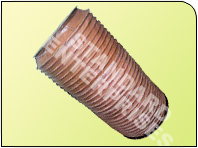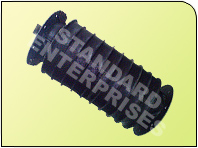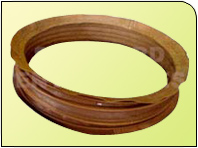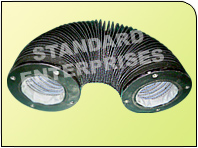Round / Square, Hexagonal, Octagonal Bellows
Round / Square, Hexagonal, Octagonal Bellows as normally used to cover the Piston Rod, Shafts, Ball Screws from dust, Coolant and Metal Chips
Bellows are flexible, accordion-like devices used in various industries to cover moving parts, protect delicate components, or facilitate movement between two elements while maintaining an enclosed environment. They come in various shapes to accommodate different needs and applications. Let’s delve into the specifics of some popular shapes: round/square, hexagonal, and octagonal bellows.
1. Round / Square Bellows
Bellows are used in various industries and applications to accommodate movements, vibrations, and misalignments while containing and protecting vital components. Bellows can be found in applications ranging from industrial machinery to camera lenses. The shape of a bellows, whether round or square (or rectangular), often depends on the application's specific requirements.
Features of Round Bellows
- Uniform Expansion : Round bellows provide uniform expansion and contraction in all directions. This can lead to more predictable performance in certain applications.
- Flow Characteristics : In fluid transmission applications, round bellows may offer smoother flow characteristics due to their circular cross-section.
- Pressure Distribution : Round bellows may handle internal or external pressures more effectively due to the uniform stress distribution around the circumference.
- Common Usage : Round bellows are commonly used in pipe and tubing systems, as well as in applications like cameras and certain machinery.
- Aesthetics : In some applications, the round shape might be preferred for aesthetic reasons.
- Mounting : Often simpler to connect to round pipes or tubes.
Features of Square or Rectangular Bellows
- Directional Flexibility : Square or rectangular bellows may be designed to have more flexibility in one direction than the other. This can be useful in applications where specific directional movement is expected.
- Space Utilization : Square or rectangular bellows can fit more effectively in certain spaces, especially in applications with tight corners or limited room.
- Coverage : They can cover linear guide rails, rods, and other machinery components more completely in some cases.
- Laminar Flow : In some situations, the rectangular cross-section can provide better laminar flow characteristics, especially in larger systems.
- Common Usage : Square or rectangular bellows are commonly used to protect machinery components, as well as in architectural applications.
- Fabrication : Depending on the material and manufacturing process, square or rectangular bellows might be easier to fabricate in certain scenarios.
Both round and square bellows can be made from various materials, including metals (like stainless steel), rubber, fabric- reinforced elastomers, and other materials. The choice of material will depend on the specific application and environmental factors such as temperature, chemicals, and abrasion.
When selecting a bellow for a specific application, it's crucial to consider not just the shape, but also the material, expected movement, environmental conditions, and the overall design of the system.
Applications of Round / Square Bellows
Bellows, whether round or square, are mechanical devices that expand and contract, allowing for the movement of fluids or gases and accommodating movement between two parts. They are commonly made from flexible materials like rubber, leather, or metal. Here are several applications for round and square bellows
- Thermal Expansion and Vibration Absorption : In systems with pipes carrying hot fluids or gases, bellows can absorb the expansion or contraction caused by temperature fluctuations. They also can dampen vibrations from machinery.
- Machine Protection : Bellows can be used to protect sensitive equipment from dust, moisture, or contaminants. For example, in CNC machines or other precision machinery, bellows protect the guide rails and screws from metal shavings and coolants.
- Semiconductor Manufacturing : In the semiconductor industry, bellows are used in the machinery to maintain ultra-clean conditions and protect delicate components.
- Medical Devices : Bellows can be found in some medical devices where they might be used to pump or move fluids.
- Camera Equipment : Bellows are used in some cameras, especially older large format cameras and enlargers, to allow for the focusing of the lens and to control the amount of light entering the camera.
- Accordions : An accordion's musical sound is produced when its bellows are compressed and expanded, forcing air through reeds.
- Fireplace Bellows : These are used to pump air and increase the intensity of a fire. The movement of the bellows introduces more oxygen, which helps combustion.
- Vacuum and Pressure Applications : Bellows are used in systems that require changes in pressure, including vacuum systems.
- Expansion Joints : In large structures, such as bridges or buildings, bellows may be used as expansion joints to absorb movements caused by thermal expansion, seismic activity, or other forces.
- Aerospace : Bellows are used in various aerospace applications, including for compensating for volume changes in hydraulic or fuel systems, or as part of actuators or sensors.
- Laboratory Equipment : Bellows are used in lab equipment for a variety of tasks, such as isolating delicate instruments from vibrations or creating a vacuum.
- Sealing : Bellows can act as seals in certain devices, preventing the ingress of contaminants or egress of vital fluids.
- Compensators : In piping systems, bellows can act as compensators for changes in length due to thermal expansion or contraction.
- Valves : Bellows-sealed valves are often used in applications where leakage or emission of the process fluid is a concern. The bellow provides a flexible, leak-tight seal while allowing the stem to move.
Whether round or square, the choice often comes down to specific application needs, installation space, and design considerations. Generally, round bellows might be preferred for their ability to handle higher pressures, while square or rectangular bellows can fit better in certain space-constrained applications.
2. Hexagonal Bellows
Hexagonal bellows are less common than circular or rectangular bellows, but they serve specific purposes in certain engineering applications. Bellows are essentially flexible elements used to contain or convey fluids or gases while accommodating movement, such as axial compression and extension, lateral movement, or angular deflection.
Features of Hexagonal Bellows
- Adaptation to Specific Geometries : Hexagonal bellows can be used when interfacing with hexagonal components or when a hexagonal cross-sectional geometry is required.
- Lateral Stiffness : The hexagonal shape might offer a different lateral stiffness profile compared to circular bellows.
- Equalized Stress Distribution : In some configurations, the hexagonal shape might promote a more uniform stress distribution.
- Space Utilization : In situations where space is constrained or has a unique layout, a hexagonal bellow might use space more efficiently than a circular one.
- Customizability : As with other bellows, hexagonal bellows can be designed with specific materials, wall thicknesses, and convolution profiles to meet the needs of the application.
- Interlocking Capability : The flat sides of the hexagonal profile can be useful for certain attachment or interlocking mechanisms.
- Limited Rotation : If the bellows are being used to connect two components, the flat surfaces of the hexagon could restrict or limit rotation, which might be desirable in specific applications.
- Unique Flow Characteristics : For applications involving fluid flow, a hexagonal cross-sectional profile might lead to unique flow dynamics compared to a circular or rectangular profile.
It's essential to note that the choice of bellow geometry (whether hexagonal, circular, rectangular, or another shape) should be based on the specific requirements of the application. Depending on the application's demands, factors such as material choice, wall thickness, and convolution count and design will also play a significant role in the bellow's performance.
Applications of Hexagonal Bellows
Hexagonal bellows are flexible, accordion-like structures that are specifically designed in a hexagonal shape rather than the more common cylindrical shape. These bellows can contract and expand, allowing for motion absorption, compensating for misalignment, or accommodating changes in length while maintaining a barrier against external environments. The hexagonal geometry can offer unique advantages in certain applications compared to the cylindrical shape. Here are some potential applications for hexagonal bellows
- Precision Machinery : In machinery that requires precision alignment, hexagonal bellows can help to absorb any misalignment while still protecting sensitive components from dust, moisture, or other contaminants.
- Optical Systems : In advanced optical systems, the need to minimize unwanted light exposure or control the light path can be crucial. A hexagonal bellow can effectively block or control light paths in specific hexagonal or honeycomb configurations.
- Semiconductor Manufacturing Equipment : Hexagonal bellows might be used in equipment where precise movements and particle-free environments are essential.
- Architectural and Aesthetic Purposes : Their unique shape can be integrated into designs for both functional and aesthetic reasons.
- Vibration Control : For machinery or systems sensitive to vibrations, hexagonal bellows can provide a degree of isolation, absorbing and dampening unwanted movements.
- Thermal Expansion Compensation : In systems where components might expand or contract due to temperature changes, hexagonal bellows can help compensate for these changes, ensuring continued operation without mechanical stress.
- Aerospace and Defense : In some specialized equipment, especially those with unique space constraints or specific structural needs, hexagonal bellows could be a preferred choice.
- Flexible Joints in Robotic Systems : The hexagonal shape might offer advantages in certain robotic configurations, particularly when the flexibility needs to be combined with a specific directionality or angle of movement.
- Microfluidic Devices : On a smaller scale, bellows can be used to control fluid movement in microfluidic devices. A hexagonal shape might provide certain flow characteristics or paths that are advantageous.
- Ventilation Systems : In specific configurations, hexagonal bellows might be more efficient or easier to integrate than traditional cylindrical ones.
The specific advantage of a hexagonal bellows over a traditionally shaped bellow would depend on the exact application and the needs of the system. Often, the choice is driven by specific space constraints, desired flow or movement paths, or particular structural considerations.
3. Octagonal Bellows
Octagonal bellows refer to a specific type of expansion joint, primarily used in engineering and industry. Bellows are designed to absorb movement, such as thermal expansion or vibrations, in a piping system. The octagonal shape is just one of many shapes that bellows can take, but it has particular characteristics and features. Here are some of the features and reasons for using octagonal bellows
Features of Octagonal Bellows
- Compact Design : Octagonal bellows can fit into tighter spaces than round or rectangular bellows, making them suitable for confined applications.
- Uniform Stress Distribution : The eight-sided design ensures that the stresses from the internal pressures are more uniformly distributed, reducing the likelihood of stress concentration in any one area.
- Flexibility : Octagonal bellows are designed to absorb axial, lateral, and angular movements. This means they can handle shifts in multiple directions.
- Customization : Like other bellows, octagonal designs can be tailored to specific requirements, including the number of convolutions, the material used, and the thickness of the wall.
- Integration : They can be designed to integrate with a variety of end fittings like flanges or welded ends.
- Materials : Octagonal bellows can be made from a variety of materials, depending on the application. Common materials include stainless steel, nickel alloys, and other high-performance materials that can withstand high temperatures and pressures.
- Durability : Properly designed and maintained octagonal bellows are durable and can offer a long service life, especially when made from high-quality materials.
- Vibration Isolation : These bellows help in reducing vibrations from equipment like pumps or compressors, ensuring the safety and longevity of connected equipment.
- Cost-Effective : While the initial cost might be higher than simpler expansion joints, the enhanced performance and longer lifespan can make them a cost-effective solution in the long run.
- Safety : Properly designed bellows can prevent catastrophic failures in piping systems, protecting both equipment and personnel.
If considering octagonal bellows for a specific application, it's essential to work with experienced designers and manufacturers to ensure the bellows are properly sized and meet all the necessary performance and safety criteria.
Applications of Octagonal Bellows
- Complex machine guarding : Especially when equipment has multiple intersecting components that need coverage from different angles.
- Architectural applications : They can be used as decorative yet functional elements in buildings or other structures.
- Aerospace and defense : Octagonal bellows might be chosen for specific defense or space applications where the shape offers some performance or fitting advantage.
General Benefits of Bellows
- Protection : Bellows guard sensitive equipment from external contaminants like dust, moisture, and debris.
- Flexibility : Their accordion-like design allows for movement while maintaining protection.
- Durability : Made from materials like rubber, metal, or Teflon, they are designed to last in harsh environments.
Selecting the Right Bellow Shape
The choice between round, square, hexagonal, or octagonal bellows depends on
- Space Constraints : How much space is available and the shape of that space.
- Movement Requirements : Different shapes offer varying degrees of flexibility.
- Aesthetic Considerations : Sometimes, the choice is made based on the visual appeal of a particular shape in an application.
When choosing the ideal bellows for a specific application, always consider the operational environment, movement requirements, and any other special needs the machinery may demand.

















